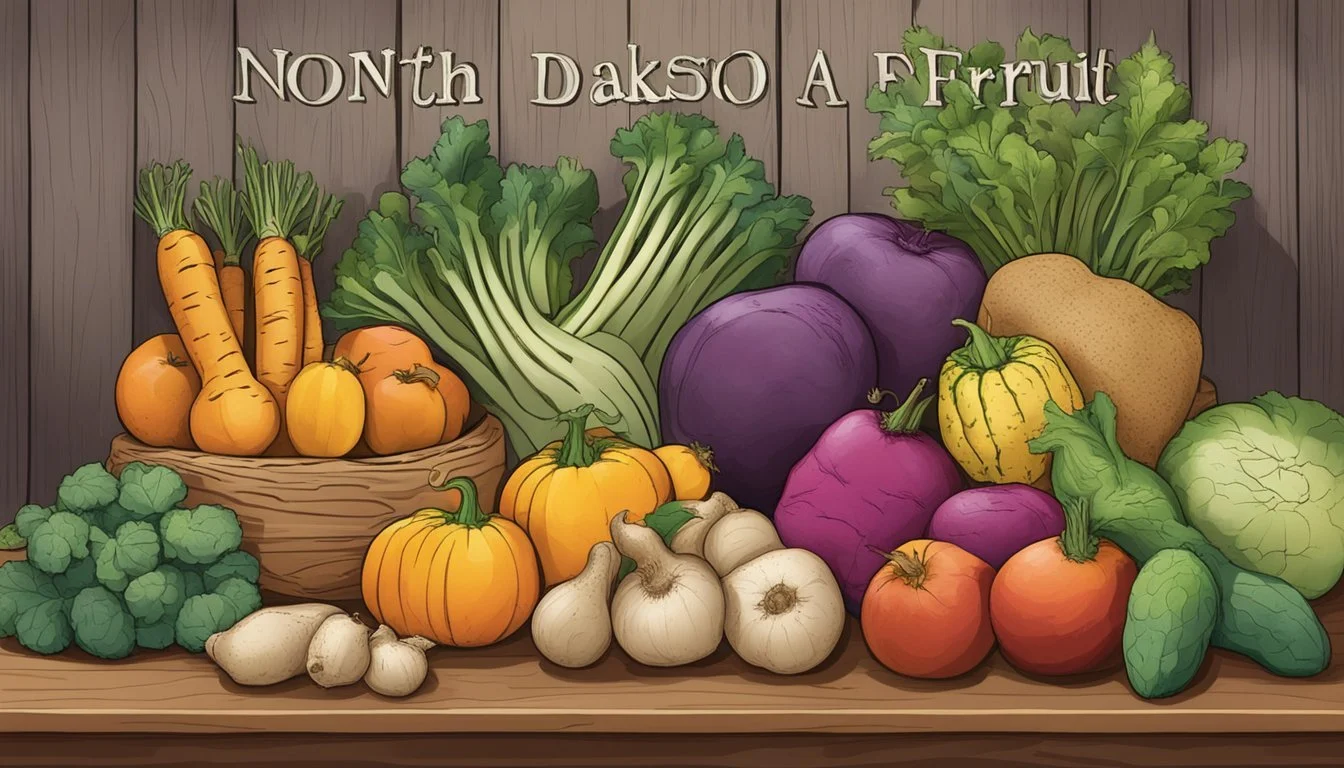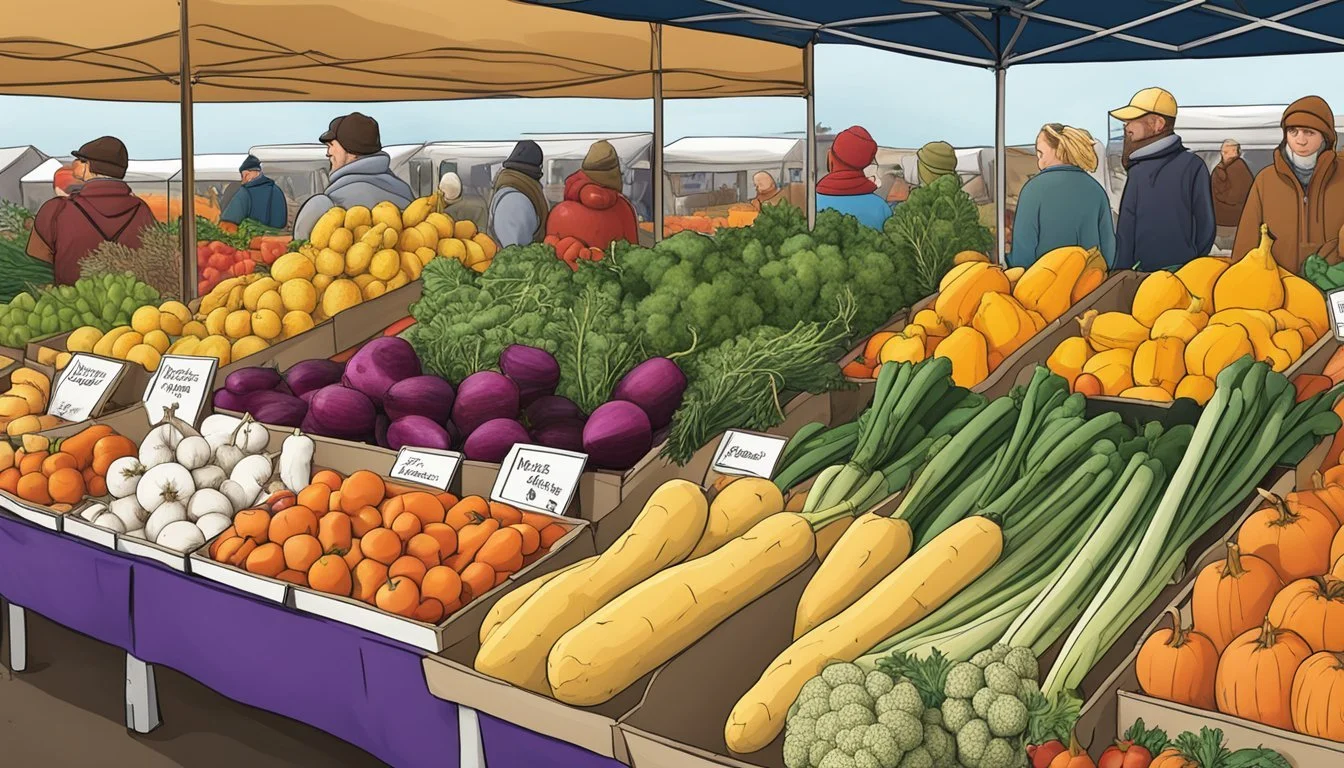North Dakota Seasonal Fruit & Vegetables in January
A Guide to Winter Produce
This Article is Part of our North Dakota Seasonal Fruit & Veg Calendar
In the midst of winter, North Dakota's harsh climate presents a unique challenge for the cultivation and harvest of fresh produce. January, often characterized by its frigid temperatures, limits the variety of fruits and vegetables that can be grown locally during this month. Despite these limitations, there are still options available for those seeking fresh, seasonal produce.
Vegetables that can withstand the cold, such as hearty kale and a variety of cruciferous vegetables like broccoli (how long does broccoli last?)and brussels sprouts (how long do brussels sprouts last?), are often available during this time. These robust vegetables become the cornerstone of seasonal eating in January in North Dakota, offering both nutrition and flavor. Additionally, root vegetables such as carrots (how long do carrots last?) and beets (how long do beets last?), which are harvested late in the year, tend to be available due to their ability to be stored effectively throughout the colder months.
Citrus fruits, although not native to the North Dakota climate, are often in season elsewhere and shipped to the region, providing a fresh, bright addition to the winter table. They add a welcome pop of color and a burst of flavor during this time when local fruit options are sparse. These imports complement the local produce and provide consumers with a wider variety of fresh options during the winter season.
Climate and Seasonality in North Dakota
In North Dakota, the climate dictates the agricultural calendar, with winter's chill impacting what produce is available and when. The state experiences extreme seasonal variances that influence its growing and harvest seasons.
Winter Weather Impact on Produce
North Dakota's winters are long and cold, with January temperatures often plunging below freezing. This season significantly influences the types of fruits and vegetables that can withstand the frosty weather, as most traditional crops are not viable outdoors. Winter weather can extend well into spring, delaying the start of the planting season and thereby affecting the timing of harvests.
Typical January weather conditions:
Average High: Around 18°F
Average Low: Approximately 0°F
Snowfall: Frequent and heavy snow at times
These conditions necessitate the use of greenhouses for any winter production of cool-season crops, such as some leafy greens and root vegetables. However, most farming activity is preparation for the upcoming growing season.
Seasonal Growth Cycles and Harvesting
The growing season in North Dakota is defined by the state's harsh winters and short, intense summers. The limited warm months prompt a condensed cycle for growing and harvesting crops. Farmers must be precise about planting dates to ensure produce matures before the first frosts of autumn.
Key points about the seasonal growth cycles:
Harvest for cool-weather crops begins as early as May.
Warmth-loving fruits and vegetables are generally not ready for harvest until mid-summer through early fall.
Harvesting typically ends by late September or early October, before the first hard freeze.
The seasonality of North Dakota's produce is a response to its distinctive climate patterns. These patterns demand adaptability from local farmers, as they work to bring fresh, seasonal produce to market within a relatively short window of favorable weather conditions.
Selection and Availability of Produce
In January, the climate of North Dakota significantly limits the availability of fresh, locally-grown produce. However, consumers can still find a selection of cold-hardy vegetables and storage-friendly fruits during this season.
January Seasonal Vegetables
Root vegetables thrive in cold storage and remain a staple in January. They retain their flavor and nutritional value well after harvest. Here's a brief list of vegetables typically available:
Carrots: Sweet and crunchy, ideal for stews and soups.
Potatoes: Versatile and filling, available in several varieties.
Onions: Aromatic and essential for a base in many dishes.
Additionally, some greenhouses may provide a limited supply of:
Lettuce: Though availability is less common, some greenhouse operations can supply fresh greens.
Spinach: Hardy in cooler temperatures and sometimes grown in controlled environments during winter.
January Seasonal Fruits
Fruit availability is sparse in January due to North Dakota's winter. However, certain storage fruits remain accessible:
Apples: Stored from autumn harvests, they continue to be crisp and sweet.
Pears: Similar to apples, they are often kept in cold storage to extend their shelf-life.
While fresh citrus fruits are not grown locally, they are in season in warmer climates and are typically imported, making them relatively abundant in grocery stores during this time.
Health Benefits of Seasonal Eating
Engaging in seasonal eating, particularly in North Dakota during January, brings forth substantial health benefits. Consumers tend to enjoy produce that is not only richer in flavor but also boasts a higher nutritional content when compared to off-season alternatives.
Nutritional Advantages
Seasonal fruits and vegetables are more likely to reach peak maturity naturally, enhancing their nutritional value. The proximity of harvesting and consumption minimizes the loss of sensitive vitamins and antioxidants that typically degrade over time. Therefore, eating seasonally aligns one's diet with foods that are at their optimal nutrient density.
Flavor and Freshness
Eating produce that is in season in North Dakota means experiencing food at its peak flavor and freshness. Seasonal fruits and vegetables are harvested at the right time, which ensures the best taste and texture. Fresh, seasonal food not only provides a superior flavor profile but also supports an individual's health by encouraging a diverse and palatable diet.
Highlights of January Produce
January in North Dakota is a time when residents can enjoy a variety of hearty vegetables that withstand the cold winter temperatures. While fruit options are limited, certain citrus fruits thrive in the winter months.
Vegetables to Enjoy
Kale: This leafy green is at its peak, providing excellent nutrition and flavor during the cold month of January.
Sweet Potatoes: A versatile and delicious root vegetable, sweet potatoes are a nutritious option packed with flavor.
Potatoes: A staple in many households, potatoes are widely available and offer endless possibilities for warming dishes.
Cabbage: With its ability to last through cold conditions, cabbage is perfect for hearty stews and soups.
Broccoli: Known for its health benefits, broccoli remains a favorite for its versatility in winter dishes.
Brussels Sprouts: These small but flavorful vegetables are a winter highlight and can be roasted to perfection.
Cauliflower: Its mild flavor makes cauliflower ideal for various culinary applications, from soups to roasted side dishes.
Beets: Earthy and sweet, beets are great for roasting or boiling and add vibrant color to any plate.
Carrots: Crunchy and sweet, carrots are available throughout the month and are perfect for a nutritious snack or addition to meals.
Turnips: Often overlooked, turnips can be mashed or roasted for a unique and tasty dish.
Parsnips: Similar to carrots, parsnips have a slightly sweeter taste, ideal for roasting or adding to hearty casseroles.
Fruits to Savor
Grapefruit: January is a great time for grapefruit, a juicy and tart citrus fruit that can brighten up the palates of North Dakota residents during the seasonal chill.
Practical Tips for Consumers
Consumers can maximize the taste and longevity of their produce purchases through proper selection, storage, and preparation. Utilizing seasonal ingredients can also enhance the flavor profile of dishes while supporting local agriculture.
Purchasing and Storing Tips
When shopping for seasonal fruits and vegetables in North Dakota during January, consumers should look for firm, vibrant, and unblemished produce. Due to the cold climate, the available variety may be limited. Here are specific tips for some commonly available produce:
Root vegetables such as beets and carrots should be firm with no signs of softness; store them in a cool, dark place.
Winter squash can be kept for a lengthier period if stored in a cool, dry place away from direct sunlight.
Cabbage and kale should have crisp leaves; keep them refrigerated and use within a week for optimal freshness.
For preserving flavor and ensuring safety, most fruits and vegetables should be stored separately to prevent premature ripening or spoilage. Additionally, some consumers may choose to extend the shelf life of their products through canning or making jams, especially with any surplus fruits like cranberries.
Preparing Seasonal Dishes
Seizing the robust flavors of January produce often involves simple preparations that highlight the natural taste of the food. While recipes should be followed for best results, here's a brief guide:
Soups and stews are perfect for incorporating a variety of root vegetables and offer a warming meal option during North Dakota's cold winter months.
Roasting can enhance the natural sweetness of root vegetables and squash. A light coating of oil, salt, and herbs can elevate their flavors.
When making jams or preserves, always use the freshest produce available and follow safe canning practices to prevent spoilage, always being attentive to the taste balance between sweetness and acidity.
Supporting Local Agriculture
Supporting local agriculture in North Dakota during January involves embracing the available winter produce and year-round products. It is an investment in the region's economy and a way to strengthen the community.
Farmers' Markets and Local Farms
Farmers' Markets: Even during the colder months, farmers' markets adapt to offer seasonal goods, preserved items, and other local farm-sourced products. These markets serve as a direct link between North Dakota's farms and the local community. In January, while fresh produce selection might be limited, markets often feature storage crops and goods from local artisans.
Local Farms: Many farms in North Dakota offer community-supported agriculture (CSA) programs, where residents can buy a share of a farm's harvest. These subscriptions can include various products, such as meats, dairy, and winter-hardy or stored vegetables, helping sustain the farms during the off-season.
Benefits of Buying Local
Economic Impact: When consumers purchase directly from local farms, they help to keep funds within the community, bolstering the local economy. Every dollar spent on local agriculture has a multiplied effect, supporting farming families and related businesses.
Community Ties: Buying local encourages a connection between growers and consumers, fostering relationships that build a strong sense of community. These interactions can lead to a better understanding of where food comes from and a greater appreciation for the agricultural heritage of the region.
Legislation and Agriculture Policy
North Dakota's legislative framework and policy directives play a significant role in shaping the state's agricultural landscape, particularly in the realm of seasonal fruit and vegetable production.
State Department of Agriculture
The North Dakota Department of Agriculture sets forth regulations to support local production and promote the state's agricultural products. One such initiative evidenced by state policy is the Seasonal Eating Guide, an educational effort to encourage the consumption of locally grown produce. This state-led guide is indicative of the commitment to align local agricultural practices with consumer habits, ensuring the seasonal availability of fruits and vegetables is well communicated to North Dakota residents.
Federal Support and Grants
At the federal level, support for North Dakota's agriculture comes through grants and programs facilitated by the United States Department of Agriculture (USDA). One pertinent example is the Fresh Fruit and Vegetable Program (FFVP), which has been implemented with the help of the North Dakota Department of Public Instruction. This program illustrates federal intervention that enables schools across the state to provide fresh produce to students, enriching their diets while also supporting local agriculture. For the 2023-2024 school year, a noteworthy allocation of $2,812,653 has supported 183 schools, benefiting 43,901 students statewide.
By navigating both state and federal regulations and funding opportunities, North Dakota's agricultural sector thrives, ensuring a steady supply of seasonal fruits and vegetables.








